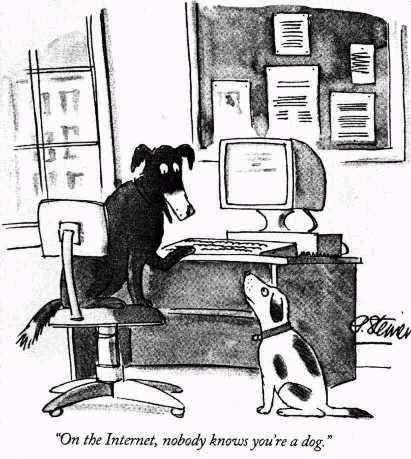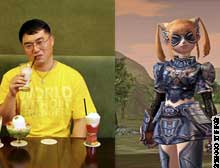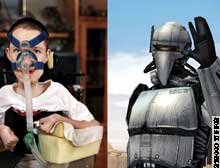Multiple Personalities/Identities Online
Contents
Group Name
Group 2 Multiple Online Personalities/Identities
Group Members
Erin Carr, Michael Meyer, Ann Pham, Denny Truong
Group Topic
A common problem with online resources for communication is the creation and existence of multiple personalities and identities for one person. This problem occurs in anything from email and messenging systems, to online forums, chat rooms, and gaming. People can create multiple identities/personalities to use as a form of deception, entertainment, or to fulfill other personal desires.
Role Playing and the Creation of Cyber Personas
Online, multiple identities occurs largely through role playing because one players become involved in the ‘consensual hallucination’ of the collective drama, they invent online personas. This largely happens within MUDSs. People indulge their fantasies without fearing the repercussions that would ensue in the offline world because that range of unacceptable behavior and expressions offered online through MUD environments far surpasses the offline world (Robinson, 2007).
Multiple self-ing occurs largely online. Users begin to invent online personas after becoming engrossed in the consensual hallucination of the online world. When people create online selves, they often resort to a signifying body, resembling bodies that are idealized in the “real” world. When users describe their virtual bodies, they exaggerate the markers of desirable characteristics that they lack in the offline world. For examples, males can characterize themselves as buff and young while females, can construct themselves as thin and beautiful because these are sought after traits in the real world.
Lost Identification
The definition of who we are is surrounded by the sense of our identity. Identity allows us to separate the differences between one another, without it there will be no way of recognizing the differentiation of our friends, family and strangers. With the explosion of the online virtual communities, our individuality and personality is threatened. The simple things we do in the real world to express ourselves, such as the daily changing of clothes, is placed in jeopardy under the virtual space environment. According to Dictionary.com, Identity is defined as “the state or fact of remaining the same one or ones, as under varying aspects or conditions.” The definition appears to be indicating that ones identity is singular, however in the virtual environment, this definition does not appear to hold true. Identity is in the online world, is transitions of the human psyche. Our psyche is what defines who we are, how others perceive of us, and how we express ourselves to others. These virtual spaces do not deal with the physical being, even though it is a major part of our identity, but with the mental visualization, social interactions, and self actualization. In the virtual world, who we are, and how we are perceived by others is fluctuating constantly because of the instability of our identity and the freedom of the online world. Where deception of whom we are is not only accepted but expected, since it may appear to be impossible to describe a person in one word or even their identity in one character, so we engage in an exploration of new windows to see who we become.
Our identity is being diluted by the online atmosphere, the sums of all the parts that make up who we are is being counteracted by the power of the internet. A user of a multiple online identity is granted the possibility to be anyone, anytime, and do almost anything that comes to mind. With the limitless existence of the virtual world, it is quite possible to step pass the boundaries of reality, giving us an endless selection of online identities. A single user can be a knight in shining armor, a stripper, and a furry bunny, all at the same time if they so choose to be. The outlines set by society on the normality of what is perceived as beauty, and fashion is evaded since the virtual self can step out of normally assumed boundaries of our physical self, such as gender, race, age and class. Although the virtual identities we create online, is correlated with who we are in the real world, it never appears to be completely the same. Minor tweaks and changes to enhance the attributes we possess in our online characters, scrambles our perception of our real self. The danger occurs when this perspective of who we are in the real world is lost, as we become consumed in the possibilities offered in the virtual world.
"Turkle perceives the Internet as an explicit example of a multiple personality, as in a chat room or Usenet one can assume a name that is male, female or ambiguous. Turkle asserts that this kind of "identity play" allows people to more fully understand the hidden aspects of themselves and, through the freedom and anonymity of the net, build a self by 'cycling through many selves'." (Parrish, 2008)
Projection
As we know a person’s identity goes beyond that of a social security number, passport photo, and sets of fingerprints. The true definition of what defines who you are is a mystery, but some would argue that a virtual identity is a truer reflection of who you are, than the identity reflected in the real world.
A photographer Robbie Cooper took on this case, and studied the relationship between the identities of the virtual world and the real world. In his studies he would take a photograph of two images, one of which is the character or avatars they used online, and a picture of their human self. Cooper manages to blend together these two portraits of the real and the virtual images, and see if the digital representations of themselves in the role playing environment where mirror images of the real life person. In a particular case a man in this 50’s, played a little girl in the online world, and said that he wanted to maintain the illusion of the character he plays. Near the beginning, in the creation of a character, you enjoy the anonymity aspect of the virtual world, but soon after, that character becomes a bigger part of your life.
Studies do suggest that virtual environments can be an escape of reality, to express different sides of ones personality. But even though it is a virtual character and the online world does not have certain rules, they tend to self regulate how they appear in the virtual world, just as if they were in the real world. When we enter the virtual worlds, certain human characteristics and behavior patterns are carried with us on to the virtual world, such as appropriate norms, what is considered proper and what is not. For example it would be rude to leave without saying good bye in real life, just as it would be rude to log off from the online world, without saying good bye. Emotions and feelings are also carried with us to the online world. It is possible to feel scared or sickened by someone’s actions in the online world, even if it appears to have no rules or boundaries.
The virtual self can be described as more “real” than the selves they embody in the offline world, according to some MUD players. In interviews with avid MUDer’s, Turkles chronicles how these users simultaneously manage many handles or cyberidentities. They believe that each part of themselves are expressed more fully in MUDS than in the real world (Robinson, 2007).
“Stone (1995) presents case studies of MUDs in which there are incidents of role playing where the self ’s online alter ego seems as ‘real’ as the offline self that gave birth to it” (Robinson, 2007). An example of such case study was the study of “Julie” which involves a male psychiatrist, impersonating a paraplegic woman online in order to gain the confidence of other women users. He then develops a biography and expressive style for “Julie”, his offline adjunct self, and reported that “Julie” was taking on a distinctive personality. By doing so, the psychiatrist felt as though he was developing a more appealing self to his online friends than his offline biological self (Robinson, 2007).
Deception
It is not unlikely that some account names can be faked, associated with their false identity claims, and their misleading social indicators. Some of which may appear to be quite harmful towards individuals or communities, if used for the wrong reasons. It is clear that these deceptive adjustments in their self presentations leave others with false impressions of who they are. In the virtual world people are granted much more flexibility in their identity, than the real world. It is not difficult to adjust your race, class, gender, age, social, economic background, or even species. This increase in flexibility allows you to be freer to define who you are, and how you look at yourself online. In the online world, there are no behavior guidelines or prescribed etiquette to enforce where your identity stands compared with everyone else.
The truth about the nature of online life is full of lies and deception. The virtual world consists of a cyber space of an anonymous arena, where it is possible to gender swap, identity deceit, and run rampages of harmful lies. Although the tragedy of such events is expected to happen, intrusion of another person’s imagined reality, if taken too seriously, their feelings can get hurt.
Trolling
Trolling is what is known as a game based on identity deception, where someone engages in creating a multiple identity to cause disruptions among discussion boards, forums, and other sources of community communications. They pretend to have common interests and concerns for the issues that arise, but in actuality this game of identity deception is played without the consent of the community, as they secretly spread bad advices and attempts to destroy the positive atmosphere within a community. With the trust factor in disarray, it is possible that new users of the community can be accused of trolling, when they make honest naïve questions. Since these naïve questions is a tool most trolls use. Once someone is labeled a troll their online reputation may be damaged, as they are immediately bombarded with angry accusations.
Sock Puppets
A sock puppet is an alternative account used for deception, particularly using 2 or more online accounts to vote more than once in a poll or to circumvent policies established on a particular website. Online websites can provide users with accounts, that overtime becomes the online identity of that particular person. Some users establishes an alternative account in addition to the account they already have in order to stir up trouble, alter results on online polls, or emphasize a point they are trying to get across to other users by pretending to have other users (which aren't really there) to agree with them. Sock puppetry can be a form of deception because users are just creating another identity to shift events into their favour. Sock puppets occurs very commonly on sites such as Wikipedia ("Wikipedia: sock puppetry, 2008).
Impersonations
Another form of identity deception is impersonations, where someone impersonates someone else. In comparison with the real world, impersonation is relatively easy, since it is not too difficult to pass as someone else online. Being in the virtual world we lack many characteristics or identity cues that identify who we are. A simple signing of the targets name might be all it takes to make others believe that you are the person you are impersonating. With such power cruel intentions can be performed by wreck havoc on their reputations either in the online or offline world.
Gender Deception
Gender deception is classical case in chat rooms and games, where someone pretends to be someone of the opposite sex. At Stanford University, California, a professor of the name Nick Yee studied the virtual reality of games where people are able to choose genders of their character. His studies have shown that male players are more likely to play female characters, than females playing male characters. Although he admits that even though this is true, there might not be a deep psychological reason for this gender swap. In the real world, it appears to be much harder for men to experience a different gender role, but the virtual world allows them to reap the rewards of another sex. However it seems that males tend to create female characters is because it is more common that female characters are being treated better in games, as they are more often to be given free gifts. Another reason is that while playing the games for twenty hours a week, it would be more pleasant to look at a female character.
Age Deception
Age deception is another case of deception. Although age deception is not as obvious to decipher, since it is impossible to really know how old someone is based on text.
Addiction
Constantly engaging in multiple online identities can lead to the formation of a habit. The huge sums of time users perform in the virtual world, absorbs in to their daily lives. Often users may lose focus in their real lives, as the window to their offline and online identities merge into one. In extreme cases it is possible to completely lose the sense of their real life identity, for the online identity. Now what defines who we are, is based solely on the ability to manufacture words. Therefore in a sense, the virtual world makes our identity more fluid, where our identity is manipulated on the commands of the user. The consistent boundary of the real world that shapes our identity fades away, as we live a life full of lie and deception from within our selves and others.
For some of the more casual users, the problems faced with multiple online identities may seem muted, as they are not fully affected by the dangers of what James Sempsey calls “Internet Addiction Disorder”. Internet Addiction Disorder occurs when people lose the sense of reality by abandoning their real lives, and spending up to 18 hours a day in virtual reality. The degree to which the addiction runs its course includes the inability to control their behaviors, due to the loss of perspectives of the real world.
Symptoms of addiction
-Feeling preoccupied with the Internet or on-line services and thinking about it while off line
-Feeling a need to spend more and more time on line to achieve satisfaction
-Inability to control your on-line use
-Feeling restless or irritable when attempting to cut down or stop your on-line use
-Going on line to escape problems or relieve feelings such as helplessness, guilt, anxiety or depression
-Lying to family members or friends to conceal how often and how long you stay online
-Risking the loss of a significant relationship, job, or educational or career opportunity because of your
on-line use
-Continuing use even after spending too much money on on-line fees
-Going through withdrawal when off line, displaying symptoms such as increased depression, moodi-
ness, or irritability
-Staying on line longer than originally intended
Escapism
Entering into the realm of the virtual world, participators of a multiple identity becomes an actor, allowing them the freedom to experiment, and stretch their imaginations. No longer are they stuck with the duties of observing others living their lives, they are able to engage in the social activities, since the virtual world provides an outlet for coping with the pressures of society and the real life problems we face such as shyness, anger, and resentment.
A common trend in the online identities is that people tend to choose an online identity that is less ordinary than their real selves. Their online characters tend to have more power or much better looking than they are in real life. Robbie Cooper looks at this statement and attempted to find someone who deliberately played a fat avatar, but was unsuccessful. It appears that the normal trend goes towards what they can not have in the real world. It seems as if in every case, the avatars are getting bigger, better, faster, and can have abilities such as flying.
Online environments leave the selection of selves to the user. Online, the a person’s virtual transcendence is rooted in the desire to escape the confines of the ‘lived body’ and the burdens of the coherent self-ing in the offline world. Multiple selves are freed from the corporeal bongs that engender unity offline therefore they can simultaneously present unrelated, multiple selves in numerous venues online. According to studies done by Turkle, Cyberself-ing offers a fresh slate for MUD users to create new online identities and provide space to work through unacknowledged or troubled parts of offline physical selves (Robinson, 2007).
Masking
It is noted that in most cases of social interaction amongst individuals in an online setting those individuals present a “mask” of their identity. This is more prominent online than it is in real (it does also occur in the real world, as well as online) because of the fact that individuals have a greater ability to choose which pieces of themselves they are willing to share with others. Individuals online also have a greater choice in what they can display, of their personalities, when engaging in online communication. It is suggested that “masking” has the ability to bring out different qualities that are actually true of the subject. The more the user builds up articles, blogs, posts, or conversations the more of themselves are able to come out of the mask that they have chosen to put in place. This is demonstrated most strongly in the personas that individuals take on (an example of this is given that if a person chooses to impersonate a rock star this may be illustrating an interest in rock music). In that light, even if a person decides to hide behind a completely different “mask” online, they may be revealing certain facets of their true identities.
A second question is raised from this idea, is “masking” necessary for interaction online? In many cases people are reluctant to involve themselves in online discussions, because of certain emotional or psychological dynamics. There are many fears that arise from communicating online including identity theft, or abuse. The ability to present a mask provides users with a safety net, in which they decide what of themselves is displayed to others, for protection from abuse etc.
Terminologies
Virtual Identities: The identities formed and used in cyberspace, often reflecting people's sense of self in the offline world.
Offline Self: Embodied self in the "real" world.
Cyber-Selfing: The creation of the online self
MUDS (Multi-User Dungeon): According to Wikipedia.com, a MUD is a multi-player computer hame, hack and slash style computer fames and social chat rooms.
MUDers: The users of Multi-User Dungeons
References
Ann's References
1. http://en.wikipedia.org/wiki/Online_identity
2. http://wiki.media-culture.org.au/index.php/Virtual_Identities
3. http://drinkthis.typepad.com/answer_this/myspace/index.html
4. http://www.schneier.com/blog/archives/2006/12/hacking_reputat.html
5. http://www.readwriteweb.com/archives/throwaway_identities.php
6. http://www.zephoria.org/thoughts/archives/2007/01/01/ephemeral_profi.html
7. http://www.guardian.co.uk/technology/2001/oct/11/news.onlinesupplement1
8. http://en.wikipedia.org/wiki/Wikipedia:SOCK
9. http://www.baselinemag.com/c/a/Intelligence/Multiple-Online-Personas-The-Choice-of-a-New-Generation/
10. http://www.helium.com/tm/190040/virtual-reality-another-cyberspace
11. http://nms.sagepub.com/cgi/content/abstract/9/1/93
Erin's References
1. http://www.theregister.co.uk/2001/05/18/murderer_confesses_on_anandtech_forum/
2. http://en.wikipedia.org/wiki/Avitar
3. http://en.wikipedia.org/wiki/Mmorpg
4. http://en.wikipedia.org/wiki/Troll_%28internet%29
5. http://www.giganews.com/usenet-history/
6. http://denbeste.nu/essays/trust.shtml
8. http://gtresearchnews.gatech.edu/newsrelease/TGAME.html
9. http://onguardonline.gov/idtheft.html
10. http://www.blockstar.com/blog/blog_timeline.html
Denny's References
1. http://www.cnn.com/2007/TECH/06/07/virtual_identity/index.html\
2. http://smg.media.mit.edu/papers/Donath/IdentityDeception/IdentityDeception.pdf
3. http://www.qualitative-research.net/fqs-texte/1-01/1-01bowker-e.htm
4. http://www.joandimicco.com/pubs/dimicco-millen-group07.pdf
5. http://www.accessmylibrary.com/coms2/summary_0286-767028_ITM
6. http://socserv2.mcmaster.ca/soc/courses/stpp4C03/ClassEssay/muds.htm
7. http://www.codinghorror.com/blog/archives/001019.html
8. http://www.michaell.org/2007/12/online-identities.html
9. http://www.christine.net/2006/07/facing_challeng.html
10. http://www-usr.rider.edu/~suler/psycyber/identitymanage.html
11. http://dictionary.reference.com/browse/identity
Michael's References
1. http://blog.ning.com/2007/10/multiple_personalities.html
2. http://www.patentstorm.us/patents/6487584-description.html
3. http://en.wikipedia.org/wiki/Online_identity
4. http://en.wikipedia.org/wiki/On_the_Internet%2C_nobody_knows_you%27re_a_dog
5. http://proceedings.informingscience.org/IS2002Proceedings/papers/Pinne088Inter.pdf
6. http://smg.media.mit.edu/people/Judith/Identity/IdentityDeception.html
7. http://en.wikipedia.org/wiki/Internet_addiction_disorder
8. http://www.4-adhd.com/internet-addiction.html
9. http://csmt.uchicago.edu/glossary2004/fantasy.htm
10. http://www.nps.navy.mil/Content/CS/ncrowe/virtcomm160.htm




.png)